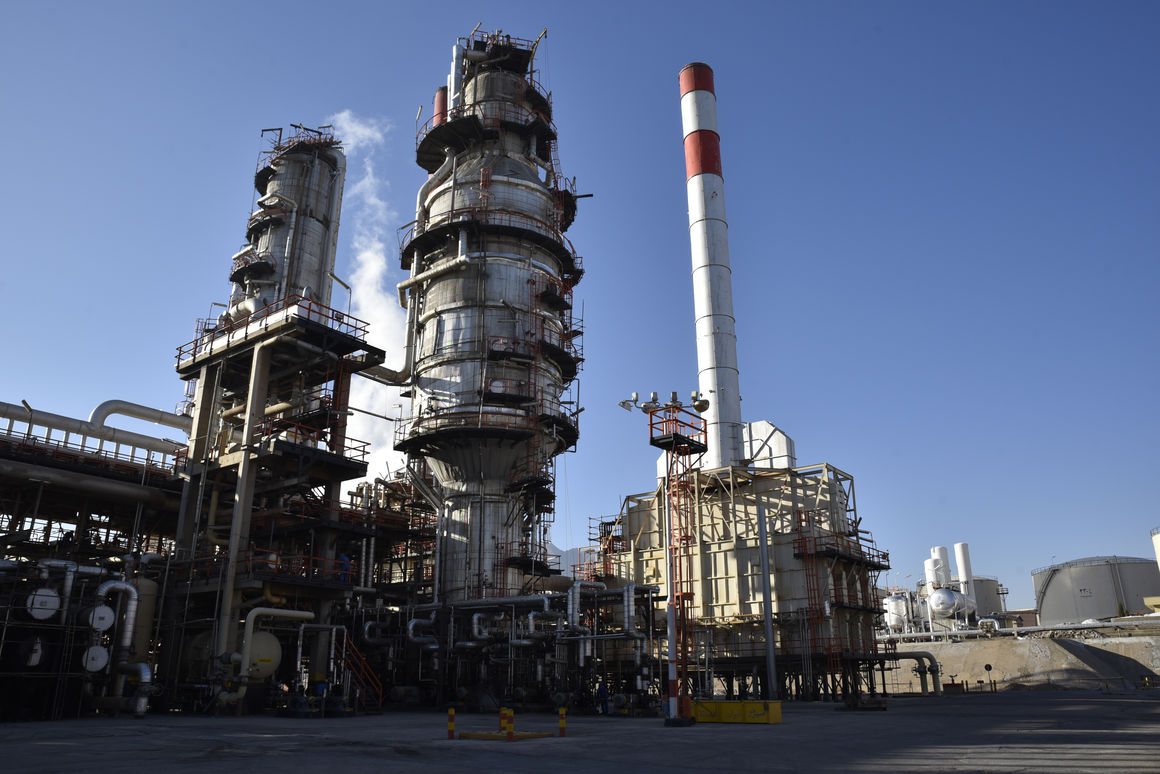Isfahan refinery was designed jointly by an American and a German company in 1973 in order to refine crude oil and petroleum products and feed downstream industries. It came on-stream in 1979 by Iranian engineers.
The treatment facility comprises two almost identical refineries, the most significant of which incorporates distillation, liquefied petroleum gas (LPG) production, viscosity reduction, catalytic conversion, hydrogen production, isomax, gasoline production, special solvents, utilities and steam, and amine and sulfur recovery divisions.
The crude oil needed by the refinery is supplied from Maroun oil center, located 70 kilometers from Ahvaz. A 430-kilometer pipeline, dotted with seven compressor stations, provide the required oil.
A comprehensive processing improvement project is currently under way at Isfahan refinery as one of the most significant environmental plans at this giant refining facility, aimed at upgrading the quality of petroleum products and reducing fuel oil output.
Complex Catalysts
Morteza Ebrahimi, CEO of IORC, said the core products supplied by this company were gasoline, gasoil and fuel oil.
“Given the requirement for the refineries to reduce environmental pollution and upgrade the quality of refined products, we are currently implementing projects to upgrade the quality of our three major products (gasoline, gasoil and fuel oil), which make up the bulk of our production,” he said.
Gasoline is a strategic refined product in Iran. Over recent years, Iran’s Petroleum Ministry has obligated all crude oil refining units to upgrade the quality of their gasoline. That requires the supply of necessary catalyst.
IORC had such policy on its agenda, but the implementation of this policy coincided with tough sanctions against Iran’s petroleum industry, which barred any entry of catalysts into Iran for different sections of the refining industry.
Ebrahimi said: “Upgrading the quality of gasoline produced at this company started during sanctions, but when the project was 90% complete the sanctions were toughened such that we were not allowed to buy rotary equipment to keep catalysts running. Foreign companies did not come to install and launch the compressors either. Therefore, we decided to hire domestic companies to design this catalyst and launch compressors.”
Therefore, Isfahan refinery produced the most sophisticated refining catalyst in the world for gasoline production, which was monopolized by American and French giants, and launched the gasoline plant in 2015. By supplying an average 11 ml/d of Euro-4 gasoline, the facility has largely contributed to reducing air pollution in Isfahan and other megacities. Furthermore, gasoil refining units for Euro05 gasoil production are 93% complete now. Operation of this project would help Isfahan refinery supply more than 20 ml/d Euro-5 gasoil. Currently, 1.5 ml/d of Euro-5 gasoil is being supplied for daily use in cities.
Meantime, some units are under construction at the refinery to remove about 100,000 b/d of heavy fuel from the facility’s mix and rather than that add environmentally friendly products.
IORC is supplying the gasoline needed in12 provinces across Iran, Ebrahimi said. “By operating quality upgrade projects at this company, gasoil pollution will be reduced next [calendar] year and we will be producing Euro-4 and Euro-5 gasoil.”
No Sanctions-Caused Halt
Fuel oil is among highly polluting products. Upgrading the fuel oil unit was among IORC plans and to that effect an agreement was signed with South Korea’s Dailem. But due to US sanctions against Iran’s petroleum industry, the Korean company left Iran.
“Given the capabilities of domestic companies, arrangements have been made to continue the project with domestic companies,” said Ebrahimi.
He said IORC’s fuel oil production capacity stood at 30 ml/d, adding the current output varied between 10 ml/d and 18 ml/d.
“Based on environmental obligations, fuel oil production will be zeroed. Furthermore, given the fuel oil quality upgrade project we plan to bring fuel oil production to zero in four years,” he added.
Ebrahimi referred to the sulfur production unit of IORC, saying: “This unit whose capacity stands at 630 tonnes a day is to come online by the end of the current [calendar] year.”
Phase III Distillation Unit
The refining capacity of IORC was 200,000 b/d at startup. The figure has now nearly doubled to 378,000 b/d. That is why separating towers are supplying a variety of products. This traffic of products will be reduced once the distillation section of the refinery comes online. Furthermore, the quality of other refined products will be upgraded.
The startup of the distillation unit will significantly cut pollution caused by the refined petroleum products. Consequently, the refinery’s fuel oil output will decline.
The IORC chief said the refinery’s distillation capacity is beyond the current 145,000 b/d. “Therefore, when the distillation units are overhauled our production capacity does not fall,” he added.
IORC will bring its operation to an optimum level with the startup of Phase III distillation unit. Distillation units 1 and 2 will be producing 120,000 b/d of petroleum products while the viscosity units of the refinery will switch from crude oil fractioning cycle to fuel oil fractioning.
Courtesy of Iran Petroleum


Your Comment